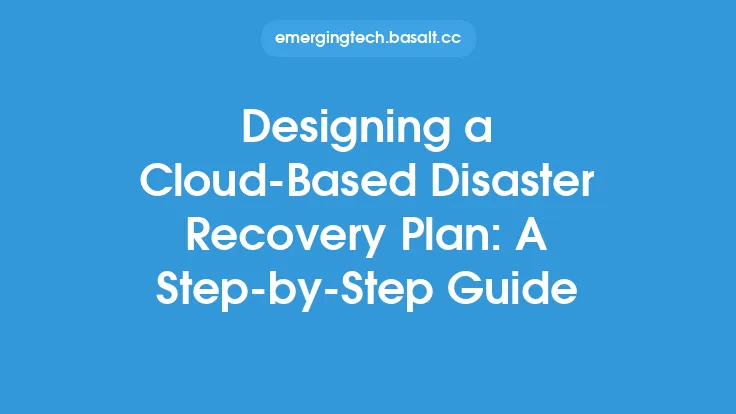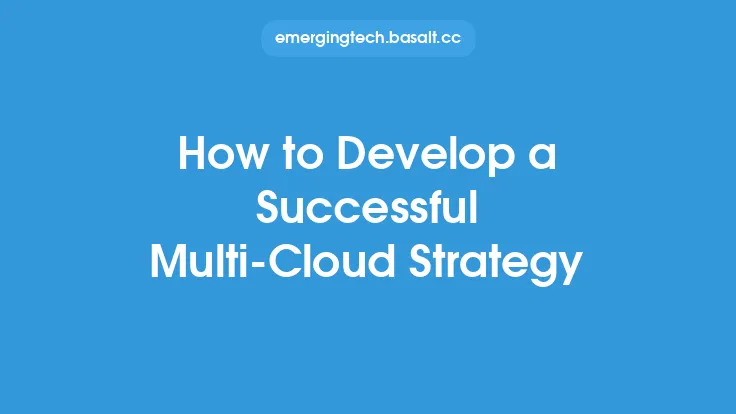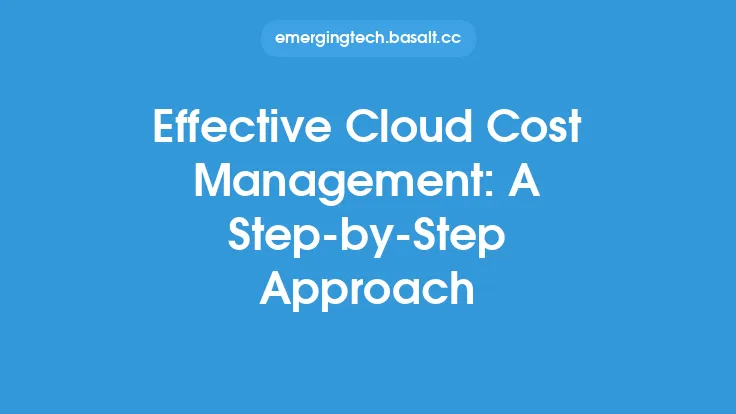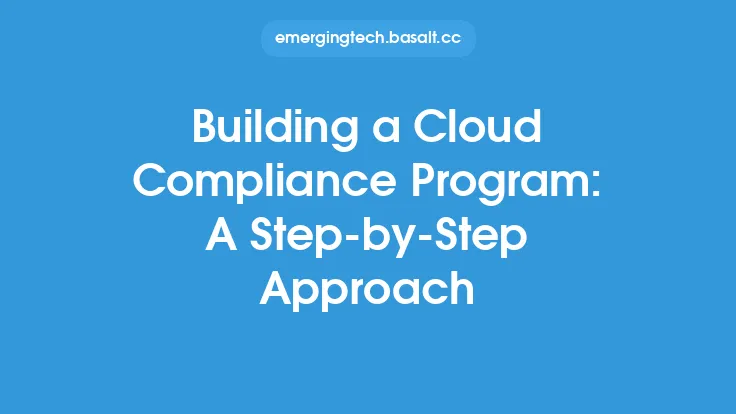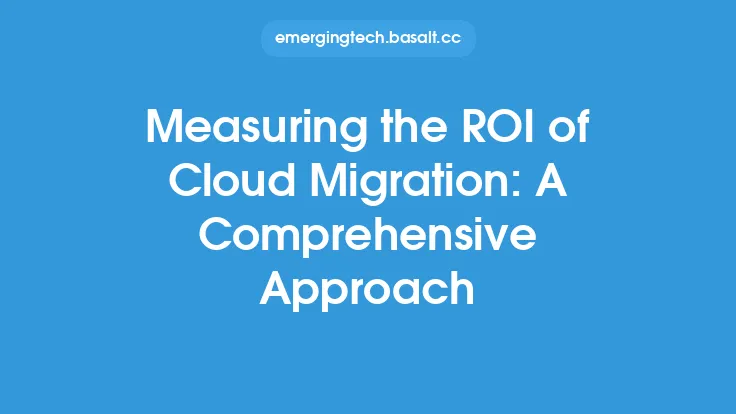When it comes to migrating to the cloud, many organizations are unsure of where to start. The process can seem daunting, with numerous factors to consider and potential pitfalls to avoid. However, with a clear understanding of the steps involved and a well-planned approach, businesses can ensure a successful transition to the cloud. In this article, we will provide a step-by-step guide to cloud migration, covering the key phases and considerations involved in this complex process.
Planning and Assessment
The first step in any cloud migration project is planning and assessment. This phase involves evaluating the organization's current infrastructure, applications, and data to determine which elements are suitable for migration to the cloud. It is essential to identify the business goals and objectives that the cloud migration is intended to achieve, such as cost savings, increased scalability, or improved disaster recovery. A thorough assessment of the organization's IT environment, including its applications, data, and infrastructure, is necessary to determine the best approach for cloud migration. This assessment should include an evaluation of the organization's security, compliance, and governance requirements, as well as its current IT service management processes.
Choosing a Cloud Provider
Once the organization has determined its cloud migration goals and assessed its IT environment, the next step is to choose a cloud provider. There are several factors to consider when selecting a cloud provider, including the provider's reputation, security, and compliance features, as well as its pricing model and service level agreements. The organization should also evaluate the provider's ability to meet its specific needs, such as support for specific applications or data types. Some of the most popular cloud providers include Amazon Web Services (AWS), Microsoft Azure, Google Cloud Platform (GCP), and IBM Cloud. Each of these providers offers a range of services and features, and the organization should carefully evaluate its options to determine which provider best meets its needs.
Migration Strategy
With the cloud provider selected, the next step is to develop a migration strategy. This involves determining which applications and data to migrate to the cloud, and in what order. The organization should prioritize its most critical applications and data, and develop a phased migration plan to minimize disruption to its business operations. There are several migration strategies to consider, including lift and shift, re-architecture, and hybrid approaches. The lift and shift approach involves migrating applications and data to the cloud with minimal changes, while the re-architecture approach involves redesigning applications to take advantage of cloud-native features. The hybrid approach involves combining on-premises and cloud-based infrastructure to create a flexible and scalable IT environment.
Data Migration
Data migration is a critical component of any cloud migration project. This involves transferring data from the organization's on-premises infrastructure to the cloud, while ensuring data integrity, security, and compliance. The organization should develop a data migration plan that takes into account the volume and complexity of its data, as well as its data governance and compliance requirements. There are several data migration tools and techniques available, including data replication, data synchronization, and data transformation. The organization should carefully evaluate its options to determine the best approach for its specific needs.
Application Migration
Application migration involves migrating the organization's applications to the cloud, while ensuring minimal disruption to its business operations. This involves assessing the application's compatibility with the cloud provider's platform, as well as its dependencies and integrations with other applications. The organization should develop an application migration plan that takes into account the application's complexity, as well as its security, compliance, and governance requirements. There are several application migration tools and techniques available, including containerization, serverless computing, and cloud-native development. The organization should carefully evaluate its options to determine the best approach for its specific needs.
Security and Compliance
Security and compliance are critical considerations in any cloud migration project. The organization should ensure that its cloud-based infrastructure and applications meet its security and compliance requirements, including data encryption, access controls, and auditing. The organization should also ensure that its cloud provider meets its security and compliance requirements, including SOC 2, HIPAA, and PCI-DSS. There are several security and compliance tools and techniques available, including cloud security gateways, cloud access security brokers, and cloud-based identity and access management. The organization should carefully evaluate its options to determine the best approach for its specific needs.
Testing and Quality Assurance
Testing and quality assurance are essential components of any cloud migration project. The organization should develop a testing plan that takes into account the complexity of its applications and data, as well as its security, compliance, and governance requirements. The organization should test its cloud-based infrastructure and applications to ensure they meet its performance, scalability, and reliability requirements. There are several testing tools and techniques available, including cloud-based testing platforms, automated testing frameworks, and continuous integration and continuous delivery (CI/CD) pipelines. The organization should carefully evaluate its options to determine the best approach for its specific needs.
Deployment and Cutover
The final step in any cloud migration project is deployment and cutover. This involves deploying the organization's cloud-based infrastructure and applications, and cutting over from its on-premises infrastructure. The organization should develop a deployment plan that takes into account the complexity of its applications and data, as well as its security, compliance, and governance requirements. The organization should also ensure that its cloud-based infrastructure and applications are properly configured, and that its users are properly trained. There are several deployment tools and techniques available, including cloud-based deployment platforms, automated deployment frameworks, and continuous integration and continuous delivery (CI/CD) pipelines. The organization should carefully evaluate its options to determine the best approach for its specific needs.
Post-Migration Activities
After the cloud migration is complete, the organization should conduct post-migration activities to ensure the success of the project. This includes monitoring the performance of its cloud-based infrastructure and applications, as well as its security, compliance, and governance requirements. The organization should also conduct a post-migration review to identify lessons learned and areas for improvement. There are several post-migration activities to consider, including cloud cost optimization, cloud security monitoring, and cloud-based IT service management. The organization should carefully evaluate its options to determine the best approach for its specific needs. By following these steps and considering these factors, organizations can ensure a successful cloud migration that meets their business goals and objectives.
